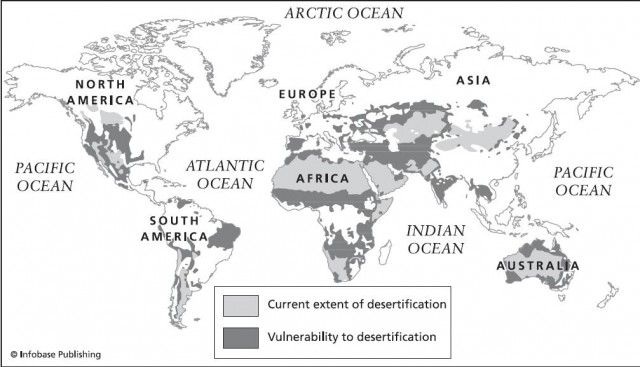In the Grip of a Dry Climate
The Sahara remains the preeminent example of a midlatitude desert formed as a result of the way in which heating at the equator drives the atmospheric circulation of the whole planet. Moist, heated air rises high into the atmosphere at the equator, which draws the steady flow of the trade winds in the midlatitudes. The air from the equator drops most of its moisture as it rises and cools, which nourishes the tropical rain forests that girdle the equator. The now-dry air flows north in the Northern Hemisphere, cooling as it rises. Eventually, this cold, heavy, dry air sinks toward the surface to replace the air rushing toward the equator in the form of the steady trade winds. All around the globe, deserts mark where this dry air drops to the surface.
The Sahara started its intermittent desert phase some 5 million years ago, when the continents moved into more or less their present condition and planetary atmospheric circulation patterns took their present form. Ever since, the Sahara has gone through cycles of long-term climatic drought, sometimes lush grassland and sometimes harsh desert. Human beings in the past 7,000 years may have actually helped extend or maintain those periods of greater moisture by growing crops and grazing cattle. The climate and extent of the desert has been especially stable in the past 2,000 years. However, shifts in the Earth's orbit and tilt plus the feedback effects of wind patterns and climate have resulted in a few unusual periods, like the Little Ice Age of the 16th through the 18th centuries.

Climatically, the Sahara breaks down into northern and southern halves. In the south, the dry subtropical climate features very high temperature ranges, freezing winters, scalding summers, and rainfall peaks in both summer and winter. This climate supports more plants, animals, and humans than the much harsher north. In the north, stable high-pressure cells centered over the tropic of Cancer ward off any rain-bearing clouds. In this area, the average annual daily temperature range is about 68°F (20°C), with hot summers and cold winters. The Sahara claims the hottest temperature ever recorded—136°F (48°C) in Libya on the northern edge of the Sahara. Rainfall averages a scant 3 inches (76 mm) per year. Most of the rain falls in the winter, but summer thunderstorms can produce major floods. Moreover, strong, steady haboob winds can swirl the dust of the Sahara into the mid- to upper atmosphere, so that it settles on the far side of the world.